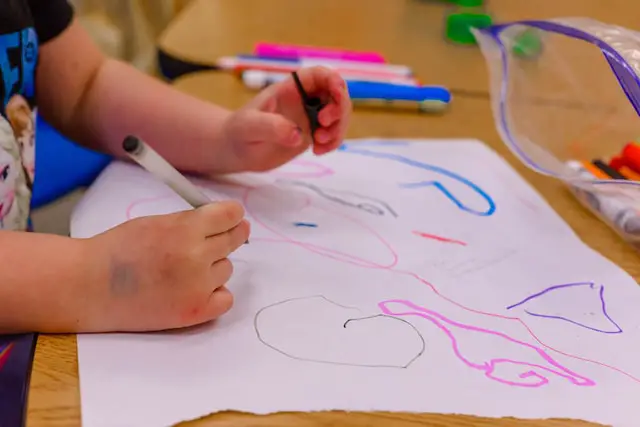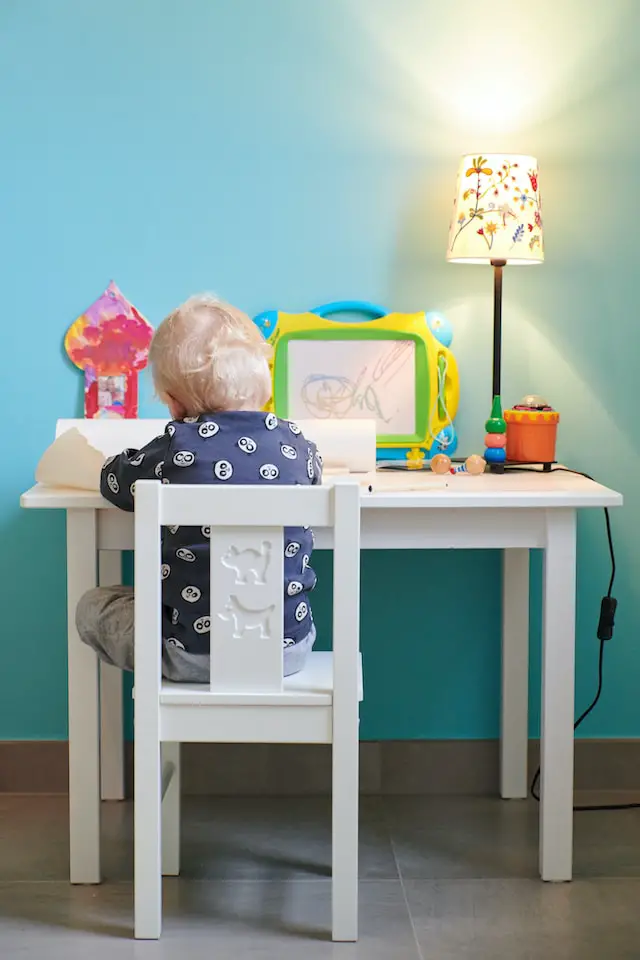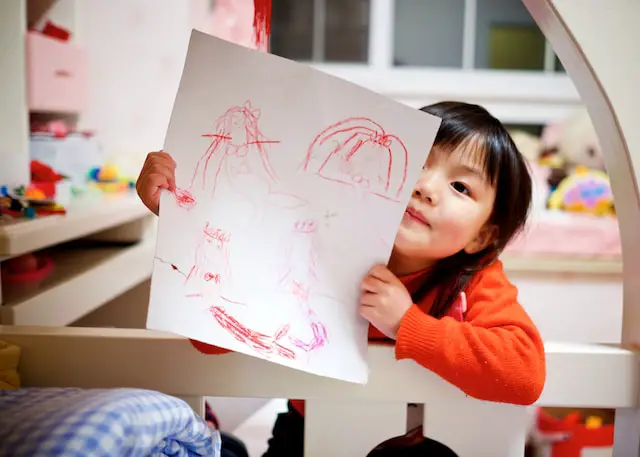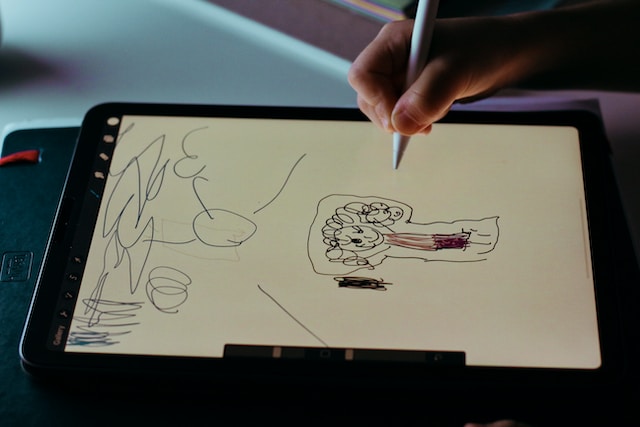Drawing is a beautiful way for children to express themselves. Developing drawing skills at an early age is crucial in advancing preschool-aged children. Drawing provides a holistic approach to learning, nurturing a child’s fine motor, cognitive, and social development. It leads to exploration, creativity, and self-expression while laying the foundation for future writing and learning success. Educators and parents might consider incorporating drawing into daily routines. By recognizing children’s interests and providing a supportive environment, we can help youngsters enjoy the process of drawing and unleash their imagination. Please remember that at this age, the goal is to foster their creativity and fine motor skills rather than aiming for complex drawings.

Typical Stages of Drawing Skills
Scribbling Stage (18 months – 3 years):
- Uncontrolled Scribbling: Initially, children make marks on a page that are not controlled and are purely an exploration of the child’s motor activity.
- Controlled Scribbling: As their motor skills develop, children gain more control over their scribbles, create patterns, different types of lines, and more purposeful marks on paper.
Pre-Schematic Stage (3 – 4 years):
- In this stage, children’s drawings become more figurative and symbolic. Children’s drawings start to have recognizable shapes and forms, though they may not be easily identifiable to adults. They might draw a face as a circle with dots or lines or represent animals and people with basic geometric shapes. Drawings often represent objects, people, and events, but they are still simple and may include little detail.
Schematic Stage (5 – 6 years):
- At this stage, children develop a ‘schema,’ or repeated and recognizable way to draw specific objects or people. They develop an understanding of spatial relationships and may start to attract more detailed scenes. For example, a drawing of a person represents a combination of different shapes and lines, with added facial features, and placed with appropriate spatial awareness. Children may begin to include a baseline in their pictures, where objects are oriented to a line.

How to Improve Preschooler’s Drawing Skills
Provide the Right Tools
Ensure that you provide your preschooler with age-appropriate drawing tools like crayons, colored pencils, markers, and washable paint. Various options make drawing more exciting and allow children to experiment with different colors, sizes, and textures. Make sure tools are accessible for small hands to grasp and manipulate. Always model the correct crayon grasp and assist with functional finger placement.
Provide Various Drawing Surfaces
Offer different types and sizes of paper for their artistic creations. Try drawing on different types of paper, plain, colored, construction paper, cardboard, and any textured or heavy paper. Additionally, consider using easels or chalkboards for additional drawing experience. Magna Doodle and LCD tablets are motivating for drawing tasks and are especially useful for longer car rides. Be cautious with using tablets.
Start with Basic Shapes
Preschoolers work on drawing various prewriting strokes, such as vertical lines, horizontal lines, circles, interesting lines, diagonal lines, squares, rectangles, and triangles.
Basic Shapes for Three-year-olds
Around three years old, they can draw lines and circles. Encourage your child to create drawings to combine vertical, horizontal, and circular strokes. Fun three-year-old practice drawing skills include simple pictures of; sun, balloon, cookie, donut, tree, flower, smiley face, snowman, road, bridge, rain, pizza, and more. Opportunities for enjoyable drawings are endless. Use your imagination and think about what you can draw with circles and lines.
Basic Shapes for Four and Five-year-olds
When preschoolers turn four and five, they draw shapes like squares, rectangles, and triangles. They can also draw diagonal, curved, zig-zags, and more. As their drawing skills advance and fine motor control improve, the opportunities to create drawings become unlimited. To list a few examples, our older preschoolers often work on pictures of themselves/self-portraits, families, animals, and houses.

Be a Role Model
Children often learn by observing. Sit down and draw alongside your preschooler. If a child struggles with drawing a specific shape, show them how to draw the shape and encourage independent practice. Demonstrate how to draw something new and show your enthusiasm for the activity. Be positive, patient, and encouraging, and you will give the child an excellent introduction to the world of drawing and creative expression.
Provide Visual Samples
By providing visual samples, it will make the drawing more straightforward. Start with a simple subject that is familiar and interesting to preschoolers. Create a graphic illustration of the picture beforehand that will serve as a model. Place the visual sample where the children can see it easily, such as on a large piece of paper, chalkboard, or digital screen (smartboard).
Break-down Drawing Skills
Breaking down drawing tasks into smaller, manageable steps can make drawing more approachable and enjoyable for preschoolers. Let’s break down the drawing of a flower into small, simple steps, focusing on shapes and lines that make up the larger picture. For example, if drawing a flower:
- Draw a small circle for the center of the flower.
- Draw petal shapes around the circle.
- Draw the line for the stem.
- Add leaf shapes.
Demonstrate each step, use different colors, and have children follow along.
Tell a Story through Drawing
Children can be encouraged to develop drawing skills to tell a story. Encourage children to figure out what they want their story to be. The drawing is child-directed and can be prompted by questions. What will your story be about? Who are the characters in your story? What happens to them? Introduce topics or themes, like family, animals, or nature, and see how they interpret them. Additionally, children can draw images based on the book or cartoon they enjoy. They can share a story about their artistic creation when their drawings are complete.
Practice and Repetition
Each time children draw, they have the opportunity to refine their drawing skills. It allows children to gradually improve their precise hand movements, refine strokes, and get better at producing the images they envision. Learning to draw can be challenging, and it teaches children that it is okay to make mistakes and that skills develop over time with consistent effort.
Praise and Encourage Process over Product
Creating something and receiving positive reinforcement can significantly increase a child’s self-esteem. Compliment the effort and enjoyment they get from drawing rather than focusing on the outcome. Say things like “I liked how hard you worked on this drawing!” or “I see you enjoyed using a lot of colors!” rather than “What a beautiful flower!” Consequently, as they develop their drawing skills, they gain confidence in their abilities.
Display Their Work
Hang children’s art creations on the walks, or have a special art show. Prominently, displaying a child’s work shows their effort is acknowledged and appreciated. It tells the child that what they have created is important. Seeing their creations on display can instill a sense of pride and accomplishment in children. It shows them that their voice, perspective, and expression are meaningful, which helps build self-confidence and creativity.

Summary
Certainly, developing drawing skills is more than an artistic endeavor in preschool. It is a complex task involving fine motor skills, cognitive processing, and creative expression. Children naturally develop and refine their drawing skills by fostering a nurturing, positive, and fun environment. Encouraging drawing skills in preschool can play a pivotal role in skyrocketing success.
Celebrate artistic creations, encourage efforts, and, most importantly, let’s have fun!
If you enjoyed this article, please share it with a friend!
Coloring Skills are Powerfull for Preschoolers’ Growth
Teaching Correct Pencil Grip to Preschoolers
Fun Animal Walk Exercises for Children
Teaching Scissor Skills to Preschoolers
Prioritize Cutting with Scissors for Preschoolers
10 Reasons Block Play Skills are Essential for Children
*Kids Groove and Grow is a participant in the Amazon Services LLC Associates Program, an affiliate advertising program designated to provide means for sites to earn advertising fees by advertising and linking to Amazon.com.


0 Comments